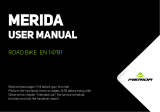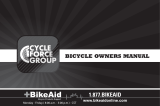
+ =
3 -- 4 mm
A B
=
A
B
1
2
1
1
2
2
4
3
+ =
3 -- 4 mm
A B
=
A
B
4
3
4
3
SI-8EL0A
BR-R560
Cable adjustment bolt
Quick release
lever
Open
Shoe fixing bolt
1
2
ST-4500 / BL-R400
BR-R560
A A
1
2
Caliper Brake
NOTE:
– To avoid serious injuries:
Technical Service Instructions
Improper use of your bicycle's brake system may result in a
loss of control or an accident, which could lead to a severe
injury. Because each bicycle may handle differently, be sure to
learn the proper braking technique (including brake lever
pressure and bicycle control characteristics) for your bicycle.
Consult your bicycle dealer and the bicycle's owners manual,
and practice your riding and braking technique.
Securely tighten the caliper brake mounting nuts to the
specified tightening torque.
Use lock nuts with nylon inserts (self-locking nuts) for nut-
type brakes.
For sunken nut type brakes, use sunken nuts of the
appropriate length which can be turned six times or more;
when re-installing, apply sealant (locking adhesive) to the
nut threads.
If the nuts become loose and the brakes fall off, they may get
caught up in the bicycle and the bicycle may fall over.
Particularly if this happens with the front wheel, the bicycle
may be thrown forward and serious injury could result.
Brakes designed for use as rear brakes should not be used as
front brakes.
Obtain and read the service instructions carefully prior to
installing the parts. Loose, worn, or damaged parts may cause
serious injury to the rider. We strongly recommend only using
genuine Shimano replacement parts.
Be careful not to allow any oil or grease to get onto the brake
shoes. If any oil or grease do get on the shoes, you should
replace the shoes, otherwise the brakes may not work
correctly.
Check the brake cable for rust and fraying, and replace the
cable immediately if any such problems are found. If this is not
done, the brakes may not work correctly.
Always make sure that the front and rear brakes are working
correctly before you ride the bicycle.
The required braking distance will be longer during wet
weather.
Reduce your speed and apply the brakes early and gently.
If the road surface is wet, the tires will skid more easily. If the
tires skid, you may fall off the bicycle. To avoid this, reduce
your speed and apply the brakes early and gently.
Read these Technical Service Instructions carefully, and keep
them in a safe place for later reference.
If using SHIMANO's road brake shoes in combination with
ceramic rims, the brake shoes will wear more quickly than
normal.
If the brake shoes have worn down until the grooves are no
longer visible, they should be replaced.
Parts are not guaranteed against natural wear or deterioration
resulting from normal use.
For maximum performance we highly recommend Shimano
lubricants and maintenance products.
For any questions regarding methods of handling or
maintenance, please contact the place of purchase.
WARNING
General Safety Information
1 mm or more
Depress about
10 times
Tightening torque:
6 – 8 N·m
{52 – 69 in. lbs.}
5 mm Allen key
In order to realize the best performance, we recommend that the
following combination be used.
Brake lever
Caliper Brake
Brake cable
After adjusting the brake shoe position so that the shoe
surface and the rim surface are as shown in the illustration,
tighten the shoe fixing bolt.
Brake shoe setting position
Set the quick release lever to the closed position; then adjust
the shoe clearance (as shown in the illustration below) and
secure the cable.
Cable connection
Make a minor adjustment by using the centering adjustment
screw.
Centering of the brake shoe
Turn the cable adjustment bolt to readjust the shoe clearance.
Readjustment of the shoe clearance
Installation of the brake lever
Depress the brake lever about 10 times as far as the grip and
check that everything is operating correctly and that the shoe
clearance is correct before using the brakes.
Check
A
Temporarily secure the outer casing to the handlebar (by
using tape or similar material).
Then wrap the handlebar with handlebar tape.
Compress the arch‚ and set while the shoe is in firm contact
with the rim.
Installation of the brake itself
Cut the cable at the length at which it is not pulled tight
when the handlebar is turned all the way to the left and
right.
If a squeaking noise occurs after a long period of use,
lubricate the parts.
Note:
Installation of the brake
The BR-R560 allows the angle of contact between the
shoe and the rim (toe-in) to be adjusted. Adjusting the
toe-in makes it possible to obtain smoother braking
operation.
Note:
Tightening torque:
8 – 10 N·m {69 – 87 in. lbs.}
Tightening torque:
5 – 7 N·m {43 – 61 in. lbs.}
Cable bolt tightening torque:
6 – 8 N·m {52 – 69 in. lbs.}
May 2006 by Shimano Inc. PIT. IZM. Printed in Malaysia
C
5 mm Allen key
Outer casing
Cable hook
Inner cable end
Outer casing
Inner cable end
Installation bolt
Cable hook
Tape
Outer casing
4 mm Allen key
These service instructions are printed on recycled paper.
Please note: Specifications are subject to change for improvement without
notice. (English)
1.
2.
1.
4.
3.
2.
3.
4.
5.
6.
The usual position
during installation is
when the head of the
centering adjustment
screw is as shown in
the illustration.
Closed
Centering adjustment screw
One Holland, Irvine, California 92618, U.S.A. Phone: +1-949-951-5003
Industrieweg 24, 8071 CT Nunspeet, The Netherlands Phone: +31-341-272222
3-77 Oimatsu-cho, Sakai-ku, Sakai, Osaka 590-8577, Japan
Direction of
rim rotation
Direction of
rim rotation
Toe-in
0.5 mm
R55C2
R
FORWARD
R55C2
FORWARD
L
Shoe Shoe
Shoe holder Shoe holder
Remove the fixing screw.
Remove the shoe by sliding it along the groove of the shoe
holder.
There are two different types of shoe and shoe holder to be
used in the left and right positions respectively. Slide the new
shoes into the grooves on the shoe holders while taking note
of the correct directions and screw hole positions.
Tighten the fixing screw.
Replacement of the cartridge shoe
Tightening torque:
1 – 1.5 N·m {9 – 13 in. lbs.}
Shoe
Same at front and rear
FrontFront
For the right
Same at front and rear
For the left
Shoe
insertion
direction
Fixing screw
Fixing screw
Fixing screw
4.
3.
2.
1.





